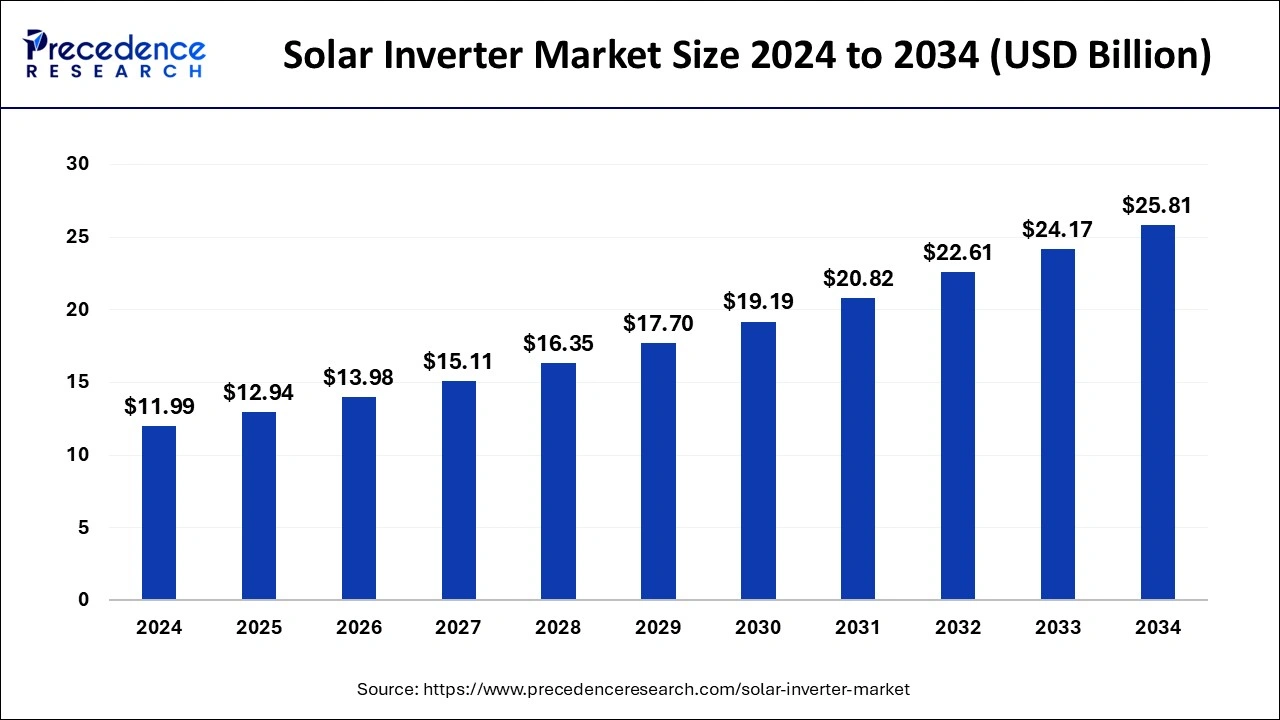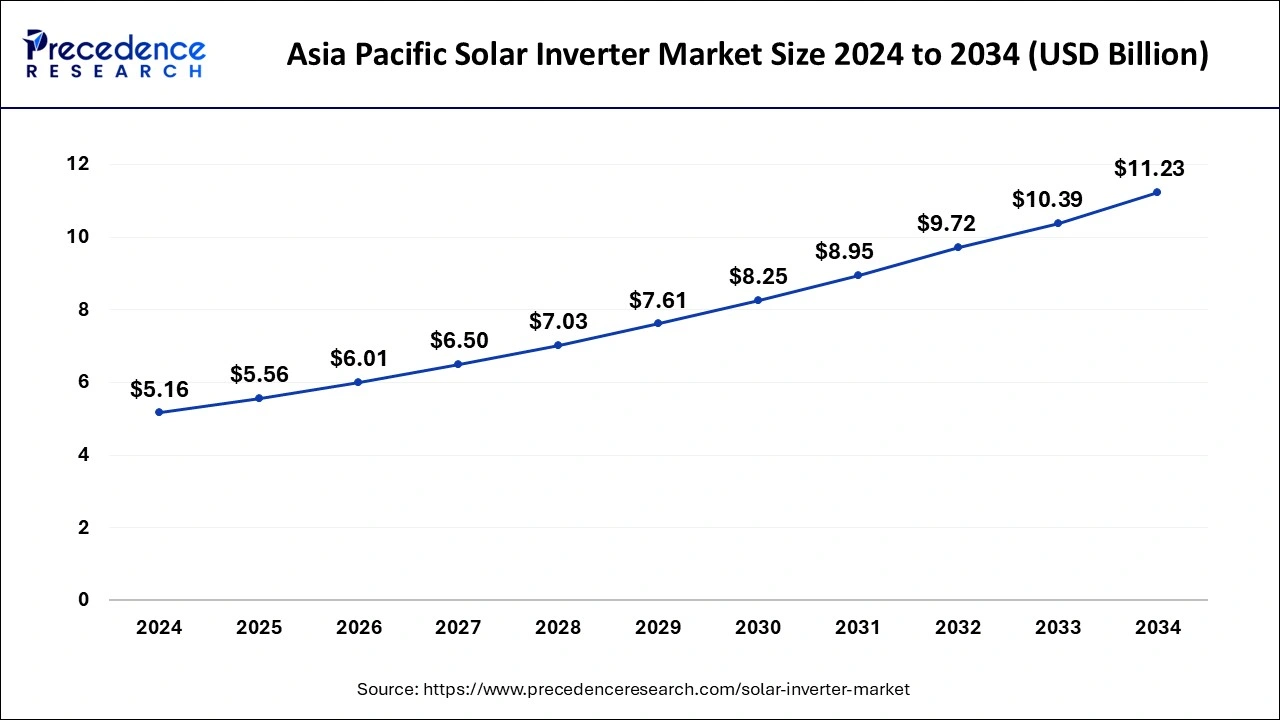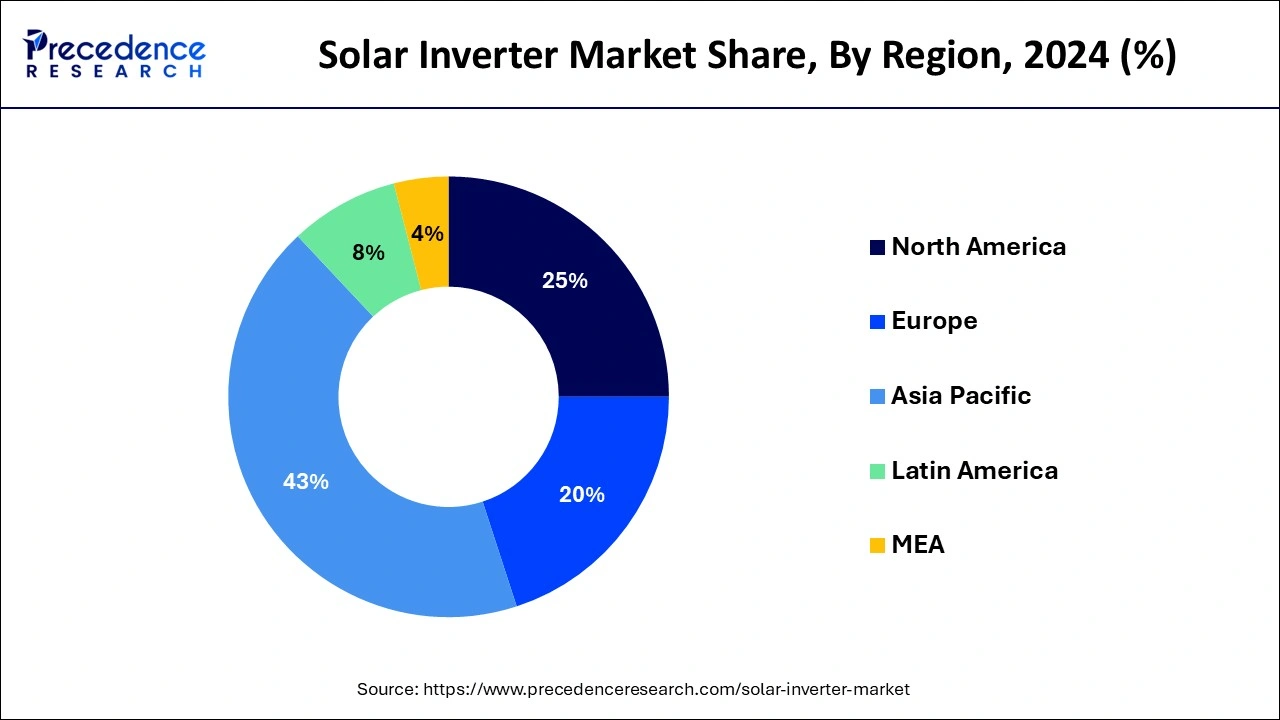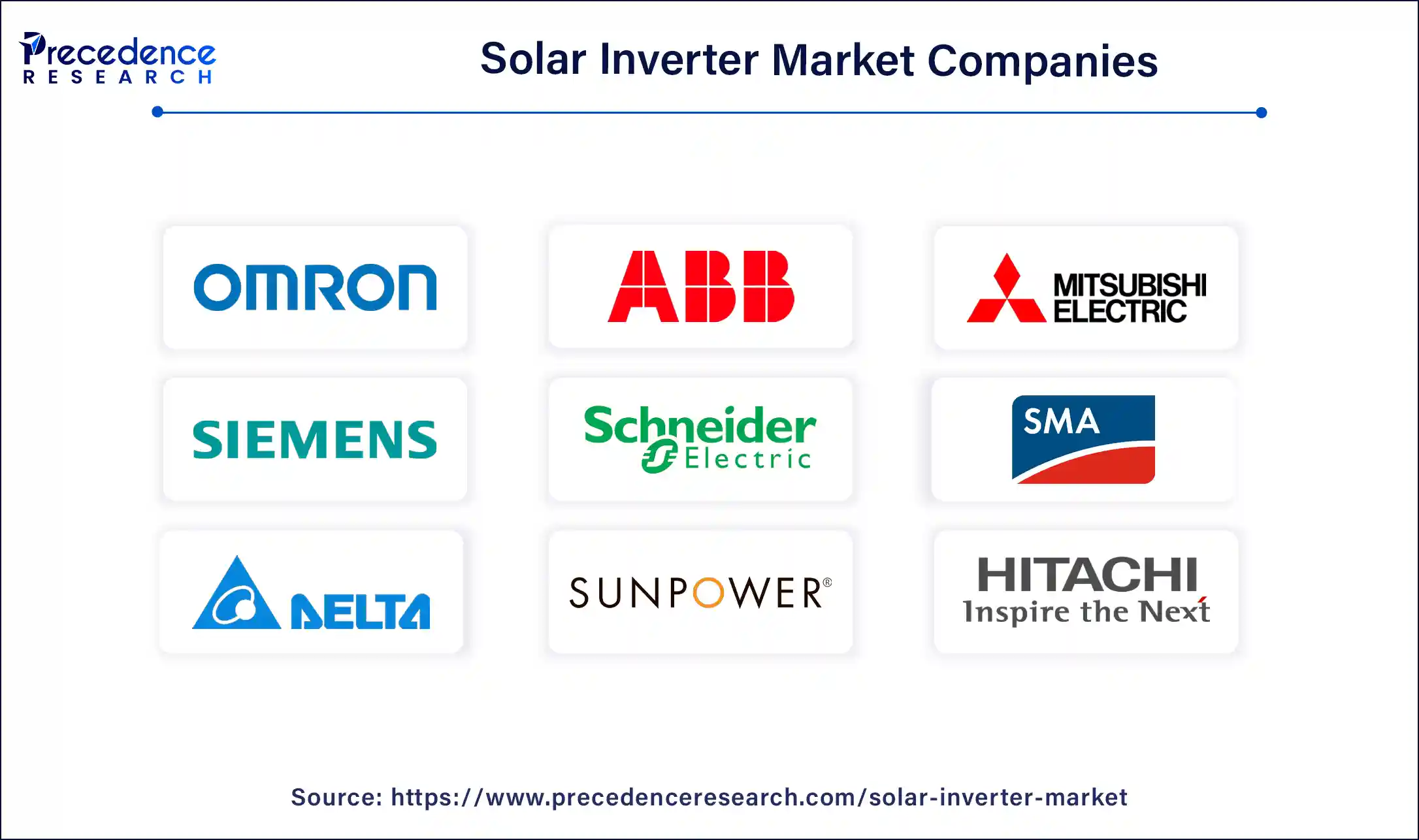Solar Inverter Market Size and Forecast 2025 to 2034
The global solar inverter market size was valued USD 11.99 billion in 2024 and is predicted to surpass around USD 25.81 billion by 2034, growing at a CAGR of 7.97% from 2025 to 2034. The power of solar inverters to regulate the flow of electric power accelerates the growth of the solar inverter market.

Solar Inverter Market Key Takeaways
- Asia Pacific dominated the global solar inverter market with the largest market share of 43% in 2024.
- North America is projected to expand at the notable CAGR during the forecast period.
- By product type, the central inverter segment contributed the highest market share in 2024.
- By product Type, the string inverter segments is estimated to be the fastest-growing segment during the forecast period.
- By connection type, the on-grid segment has held the largest market share in 2024.
- By connection type, the off-grid segments is predicted to be the fastest-growing segment during the forecast period.
Role of Artificial Intelligence in the Solar Inverter Market
Artificial intelligence maximizes the efficiency of solar panels. Advanced AI algorithms help analyze vast datasets, weather patterns, solar irradiance, and historical performance metrics. AI ensures the maximum amount of sunlight captured by solar panels, which significantly boosts energy output. AI-driven predictive maintenance systems use machine learning algorithms to manage solar farms and monitor the condition of solar panels and related equipment. AI can forecast potential failures and schedule maintenance before any breakdown by analyzing sensor data and historical performance. The integration of AI into energy storage systems is essential to optimize solar power usage. AI-powered robots and drones can perform tasks such as panel inspection, panel cleaning, and repair.
Asia Pacific Solar Inverter Market Size and Growth 2025 to 2034
The Asia Pacific solar inverter market size was estimated at USD 5.16 billion in 2024 and is anticipated to reach around USD 11.23 billion by 2034, rising at a CAGR of 8.09% from 2025 to 2034.

Asia-Pacific accounted for the largest revenue share of around 43% in 2024. Factors such as rising government initiatives and the presence of major market players in the region are propelling the expansion of the solar (PV) inverter market in Asia-Pacific.
The growing solar installation in developing nations significantly contributes to the market's growth in this region. The growing need to reduce carbon emissions and the growing awareness about environmental issues accelerate the need for solar inverters in this region. The constant economic growth in China and India and the developments in the supply chain propel the demand for this equipment. The increased utilization of solar energy and the increased manufacturing of solar equipment such as solar panels, solar devices, and solar PV inverters drive the market's growth significantly.

North America is expected to develop at the fastest rate during the forecast period. The U.S. dominated the solar (PV) inverter market in the North American region. The U.S. is dominating the solar (PV) inverter market in the North American region. In a few years, the region has seen substantial growth in the sales of central and string inverters.
The United States is prominent in the market. Moreover, central inverters are expected to drive the market's growth in the coming years. Industrial players are trying to provide consumers with industry-leading utility-scale solutions that help them achieve higher efficiency and reduced balance-of-system costs with their pre-integrated power stations. The increased demand for clean energy solutions is also driving the market's growth in this region. The favorable government policies also boost the demand and need for solar inverters in the North American market.
Market Overview
The solar inverter refers to the most important equipment in a solar energy system, which is an excellent example of a class of devices called power electronics that regulates the flow of electrical power. This equipment provides energy in several areas, such as commercial, industrial, and residential. It can be connected on-grid or off-grid. The types of this essential equipment include string inverter, central inverter, and microinverter. The commercial and industrial areas represent the main target markets for this. The rising awareness of consumers about solar inverters and the growing environmental concerns are establishing the importance of this equipment globally. It is an integral part of electricity generation. This solar power is free and adequate, while the production and manufacturing process is easy for prominent industries. The processes benefit end users because they do not need any further costs except installation and operating costs. Financially, the process is feasible and is in high demand all over the world.
Solar Inverter Market Growth Factors
- The global solar (PV) inverter market is expanding due to the rapid expansion of the renewable energy sector.
- The growing demand and need for green and clean energy drive the growth and development of the global solar (PV) inverter market over the projected period.
- The governments of developed countries and regions are taking initiatives to curb the impact of carbon and greenhouse gas emissions.
- The string solar (PV) inverter are adopted in all areas and utilities as it is effective and incurs low failure rates while operating and maintaining in large buildings.
- The string solar (PV) inverter is also low in cost as compared to other types of solar (PV) inverters.
- The implementation of a solar (PV) inverter is feasible as it has good power backup.
- Due to infrastructural development and a growing number of construction and building projects, the demand for solar (PV) inverters is growing at a rapid pace.
- Another factor that is boosting the expansion of the global solar (PV) inverter market is the growing number of home loans and home renovation projects in developed and developing regions.
- Moreover, due to the low cost and tax benefits provided by solar (PV) inverters, business owners are accepting and adopting solar (PV) inverters on a large scale.
Market Scope
| Report Coverage | Details |
| Market Size in 2025 | USD 12.94 Billion |
| Market Size by 2034 | USD 25.81 Billion |
| Growth Rate from 2025 to 2034 | CAGR of 7.97% |
| Largest Market | Asia Pacific |
| Base Year | 2024 |
| Forecast Period | 2025 to 2034 |
| Segments Covered | Product, Connection, Phase, End User, Nominal Power Output, Nominal Output Voltage, and Region |
| Regions Covered | North America, Europe, Asia-Pacific, Latin America, and Middle East & Africa |
Market Dynamics
Drivers
The favorable government policies and initiatives, the declining cost of solar panels, technological advancements in solar power, and the rising energy demand are the major rationales behind the growth of the solar inverter market. Moreover, the International Solar Alliance (ISA), rural electrification programs, solar financing, investment opportunities, etc., accelerate the market's growth. Technological innovations, including solar tracking systems, thin-film solar panels, energy storage solutions, and solar-wind hybrid systems, are shaping the future of solar energy in India.
Restraint
More solar installations connected to the grid impose challenges regarding grid integration, stability, and power quality. Solar inverters need higher efficiency to maximize the energy yield from solar installations. The need arises to ensure the durability and reliability of inverters over their lifespan to minimize maintenance costs and downtime.
Opportunity
With the high investments in high-quality solar inverters, people can enjoy reliable and cost-effective electricity in the coming years. Efforts are made to design inverters that can work in remote locations or areas with unreliable grid power. Solar power will help people reduce electricity bills and provide energy independence due to high electricity rates and limited access to the national grid.
Product Type Insights
The central inverter segment dominated the market with largest market share in 2024. The central solar (PV) inverter is widely applicable in industries. This type of inverter is used in huge buildings and industrial centers. The solar panels are installed in the rooftops of buildings which enables the smooth power supply.
The string inverter segment is fastest growing segment of the solar (PV) inverter market in 2021. The installation of string inverters is economic friendly and it is easy to install in commercial and residential areas. This type of solar (PV) inverter is effective and efficient in nature.
Connection Type Insights
In 2024, the on-grid segment dominated the solar (PV) inverter market. This is due to growing investments in the electricity and power generation. The on-grid solar (PV) inverter is cost effective in nature. The on-grid solar (PV) inverters are mostly installed in residential areas.
The off-grid segment, on the other hand, is predicted to develop at the quickest rate in the future years. The off-grid solar (PV) inverters are increasingly common and often come with a backup power supply. The solar (PV) inverters that are not connected to the grid are known as off-grid inverters.
Phase Insights
The three phase segment dominated the solar inverter market in 2024. This is because of their ability to manage higher power loads as well as support large-scale solar installations. While single-phase inverters are more usual in residential settings, three-phase inverters are important for larger systems demanding greater power output and grid stability. Three-phase inverters are vital for connecting solar systems to the power grid, permitting the efficient transfer of electricity to both on-site consumptions along with the wider grid.
The single phase segment is the fastest growing in the solar inverter market during the forecast period. This growth is driven by the rising acceptance of solar power in homes as well as small businesses, where single-phase inverters are favored because of their lower cost, simpler design, along with ease of installation. Single-phase inverters are mainly well-suited for residential solar installations, as they can efficiently power household appliances along with other electrical loads. Government incentives and subsidies promoting clean energy, together with rising electricity costs, are thus accelerating the acceptance of residential solar systems, which in turn boosts the requirement for single-phase inverters.
End User Insights
The utilities segment accounted largest market share of in 2024. The factors such as surge in demand for renewable energy and rising government initiatives are driving the growth of the segment. In addition, the solar (PV) inverter is cost effective solution for various utilities.
The residential segment is fastest growing segment over the forecast period. The people living in residential areas use large number of home gadgets and appliances. It means that the people require more amount of electricity for these gadgets. This factor is creating demand for electricity in residential areas on a large scale. Thus, the expansion of the segment is expected due to this factor.
Nominal Power Output Insights
The 3 - 33 kW segment dominated the solar inverter market in 2024. This segment is a large portion of the market, sustaining residential rooftops as well as smaller commercial buildings. The expansion of this segment is boosted by the rising popularity of residential solar installations along with the decreasing expenses of solar panels.
The 110 kW segment is the fastest growing in the solar inverter market during the forecast period. These inverters are utilized in commercial as well as industrial solar installations, and larger residential setups, and are fragment of the broader trend of increasing solar capacity.
Nominal Output Voltage Insights
The 230 - 400 V segment dominated the solar inverter market in 2024. This is mainly for commercial, residential, and small industrial applications. These inverters are versatile and suitable for a broad range of uses. 230-400V inverters are well-suited for numerous applications, making them a popular alternative.
The 400 - 600 V segment is the fastest growing in the solar inverter market during the forecast period. This surge is mainly driven by its suitability for large commercial as well as utility-scale solar projects, where higher voltage permits for longer string lengths, decreased system costs, and increased efficiency. Higher voltage inverters, such as those in the 400-600V range, permit longer string lengths in solar panel arrays. This lowers the number of strings needed, thus minimizing wiring as well as other balance-of-system costs.
Solar Inverter Market Companies

- Omron Corporation
- ABB Ltd
- Mitsubishi Electric Corporation
- Siemens AG
- Schneider Electric SE
- SMA Solar Technology AG
- Delta Electronics Inc.
- SunPower
- Hitachi Hi-Rel Power Electronics Pvt. Ltd
- Power Electronics S.L.
Recent Developments
- In February 2024, Siemens AG announced new products and partnerships to achieve transformation and sustainable infrastructure. Siemens customers get access to flagship technologies in the space, including Xcelerator, an open and innovative digital business platform offering integration with more than 400 sellers in the Siemens global ecosystem.
- In May 2024, Omron Electronic Components Europe announced a diverse range of innovations at the Smarter E Europe Exhibition 2024 to support efficiency and reduce energy losses for electric vehicle charging, electricity storage systems (ESS), and solar applications.
Segments Covered in the Report
By Product Type
- Central Inverter
- String Inverter
- Micro Inverter
- Others
By Connection
- On-grid
- Off-grid
By Phase
- Single phase
- Three phase
By End User
- Residential
- Commercial
- Industrial
- Utilities
By Nominal Power Output
- ≤ 0.5 kW
- 0.5 - 3 kW
- 3 - 33 kW
- 33 - 110 kW
- 110 kW
By Nominal Output Voltage
- ≤ 230 V
- 230 - 400 V
- 400 - 600 V
- 600 V
By Region
- North America
- Latin America
- Europe
- Asia-pacific
- Middle and East Africa
For inquiries regarding discounts, bulk purchases, or customization requests, please contact us at sales@precedenceresearch.com
Frequently Asked Questions
Ask For Sample
No cookie-cutter, only authentic analysis – take the 1st step to become a Precedence Research client
 sales@precedenceresearch.com
sales@precedenceresearch.com
 +1 804-441-9344
+1 804-441-9344